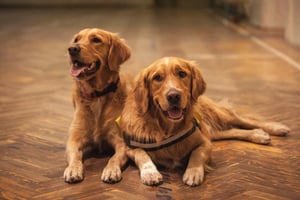If your dog's toenail is bleeding, it can be a stressful experience for both you and your pet. This...
How to Stop Dog Separation Anxiety
Don't know how to leave your dog at home alone? This article has been created to help your dog stay happy, while you are away. Let's learn how to prevent dog separation anxiety.
What causes dogs to have separation anxiety?
Dog separation anxiety can be caused by many reasons, but the main ones are: new family, new schedule or a new palce.
-
New family
When a pup moves to a new family the experience can be very stressful. If you get your pup from a breeder they are essentially separated from their family and it is unusual for them to be without their siblings. -
New place
-
New schedule
People often forget that dogs, just like humans, rely on a schedule. If you big changes to the schedule or simply change it too often it can be stressful for your dog and cause anxiety. -
New place
If you just moved to a new place the new sounds and smells can be alarming for your dog and they need more time to get used to it before staying alone.
8-Day Dog Separation Anxiety Programme
Day 1
-
Give your dog their meal in an enrichment feeder.
-
Walk to the door of the room.
-
Say “GOODBYE”, then step out of sight.
-
Wait 30 seconds, then come back in and continue with your normal activities, ignoring your dog.
Day 2
-
Give your dog their meal in an enrichment feeder.
-
Walk to the door of the room.
-
Say “GOODBYE”, then step out of sight.
-
Walk to your front door and jiggle the latch before returning immediately to your dog.
Day 3
-
Give your dog their meal in an enrichment feeder.
-
Walk to the door of the room.
-
Say “GOODBYE”, then step out of sight.
-
Walk to your front door and jiggle the latch, then open and close the door before returning immediately to your dog.
Day 4
-
Give your dog their meal in an enrichment feeder.
-
Put on your shoes and coat, gather up any bags and keys.
-
Walk to the door of the room. Say “GOODBYE”, then step out of sight.
-
Walk to your front door and jiggle the latch, then open and close the door before returning immediately to your dog. Dogs are very sensitive to patterns, and many quickly learn that when you put your outdoor gear on or pick up your bag, or your shoes, that you are going to be leaving them alone. As a result, they may become stressed before you've even departed, which will make the stress after you've left even more intense. By introducing these signals and then not leaving, you are making it easier for your dog not to experience anticipatory distress.
Day 5
-
Give your dog their meal in an enrichment feeder.
-
Put on your shoes and coat, gather up any bags and keys.
-
Walk to the door of the room. Say “Goodbye”, then step out of sight.
-
Walk to your front door and jiggle the latch, then open and close the door. Wait 10 seconds before returning to your dog.
Day 6
-
Give your dog their meal in an enrichment feeder.
-
Put on your shoes and coat, gather up any bags and keys.
-
Walk to the door of the room. Say “GOODBYE”, then step out of sight.
-
Walk to your front door and jiggle the latch, then open and close the door. Wait 30 seconds before returning to your dog.
Day 7
-
Today you'll need to practice this exercise in the morning, afternoon and evening.
-
Follow the same steps as before, but make sure you do it throughout the day. Give your dog their meal in an enrichment feeder and put on your shoes and coat, gather up any bags and keys.
-
Walk to the door of the room. Say “Goodbye”, then step out of sight.
-
Walk to your front door and jiggle the latch, then open and close the door. Wait 1 minute before returning to your dog.
Day 8
-
Today we'll work on the duration of the separation. Follow the same steps as before. Give your dog their meal in an enrichment feeder and put on your shoes and coat, gather up any bags and keys.
-
Walk to the door of the room. Say “GOODBYE”, then step out of sight.
-
Walk to your front door and jiggle the latch, then open and close the door. Go for a 10-minute walk or grab a coffee. You deserved it!
Can you train a dog to stop having separation anxiety?
The short answer is "yes", you can. You just need to do it gradually.
Unfortunately, pet parents often start worrying about separation anxiety when a dog shows strong signs of it. The best way is to start with the preventative steps that we described above. The short answer is "yes", you can.
The longer answer is depending on the severity of your dog's anxiety it will take a different amount of time.
You need to understand why your dog is anxious. There might be unusual smells or sounds.
Then you need to start leaving the room, keeping them distracted with food or toys.
What are the signs of separation anxiety in dogs?
The main signs to look for is your dog barking for a long time when left alone, urinating or defeacating if they are house trained and destoying house items
There are different signs of your dog having separation anxiety, but these are the three main ones:
-
Barking
If your dog is barking for a long time after you left, this is often an indicator of them having a separation anxiety -
Destroying things
If your pup is destroying things while you're away this is often a sign of them having anxiety. If they generally destroy things we have a separate course at Fluffy for this. (you can access it via the app for free here) -
Urinating and defecating
If your dog is trained to go outside for the toilet but do this while you're away it can also indicate that they have dog separation anxiety. Just make sure you. If they're not house-trained yet, there is a separate course that we created at Fluffy as well. (you can access it via the app for free here)
How long does it take to fix dog separation anxiety?
If you use preventative step, it can take only a week, but if your dog has severe anxiety it can be up-to a month.
The preventative steps we described above can take around 7-8 days, but you need to regularly practice this with your pup. The separation anxiety can return if you, for example, change your schedule or start leaving them for longer times at home.
We often notice that dogs that sleep in the bedroom with their parents often get more attached and struggle more with separation anxiety.
What dog breeds have the most separation anxiety?
Every dog can get a separation enxiety, but some breeds are more attached to their owners
Even though dog separation anxiety can appear in every breed, we see that the following breeds have separation anxiety more often than others. The caveat is that this can be caused by owners of a particular breed having particular characteristics. Here're the breeds we've seen that struggle the most:
-
Labrador Retriever
-
Jack Russell Terrier
-
Australian Shepherd
-
Poodle
-
Vizsla



